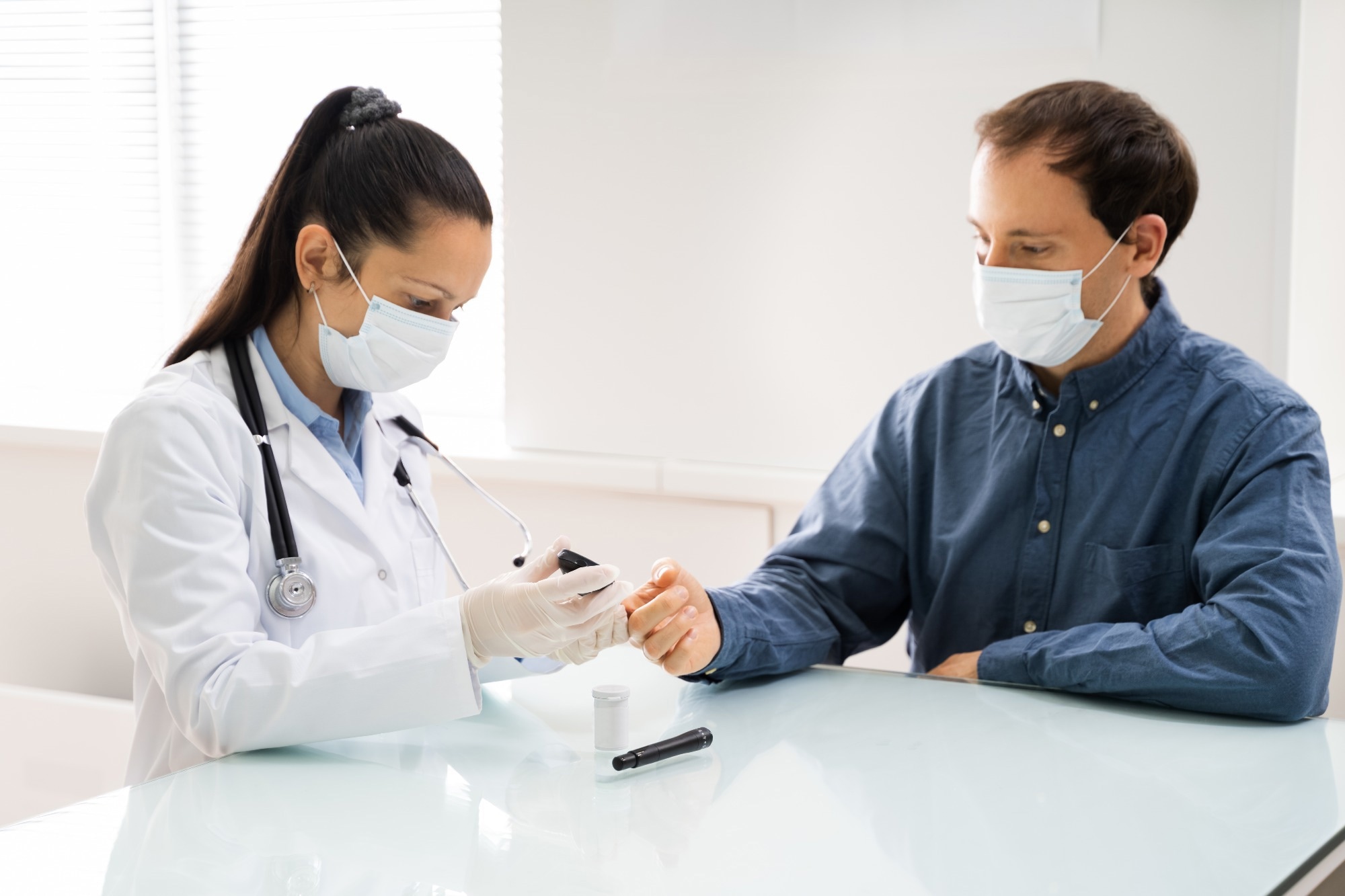In a recent review published in Nature Metabolism, researchers explored whether severe acute respiratory syndrome coronavirus 2 (SARS-CoV-2) can expedite or trigger the development of diabetes mellitus (DM).
 Study: COVID-19 and diabetes — where are we now? Image Credit: Andrey_Popov/Shutterstock
Study: COVID-19 and diabetes — where are we now? Image Credit: Andrey_Popov/Shutterstock
Recent studies have reported an elevated risk of incident DM after coronavirus disease 2019 (COVID-19); however, a causal association and the underlying biological mechanisms have not been well-characterized. The continuation of elevated glucose levels after COVID-19 has regressed, and probable non-pancreatic tissue SARS-CoV-2 infections have added a new dimension to the complexity of deciphering the true link between diabetes and COVID-19.
About the review
In the present review, researchers assessed the association between COVID-19 and diabetes.
Epidemiological and clinical evidence of diabetes and COVID-19
Multiple studies have reported an elevated risk of incident DM of type 1 (T1D) and (T2D) following SARS-CoV-2 infections. However, for T1D, epidemiological studies have reported controversial findings.
On the contrary, surveys utilizing electronic health records have documented a heightened risk of incident DM ≤12 weeks after SARS-CoV-2 infection, and the affected individuals were more likely to receive insulin prescriptions in <91 days of being diagnosed with SARS-CoV-2 infections with an excess health burden of new-onset DM and hyperglycemia (wherein >77% of patients had T2D) after a year of follow-up.
Among a few cohorts, glycaemic control was reported to improve in 63% to 79% of COVID-19 patients six months post-recovery and in 41% to 79% of COVID-19 patients 10.0 months post-recovery. In contrast, high sugar levels persisted in ≤56% of patients. Hospitalized SARS-CoV-2-positive patients having dysregulated glucose levels in acute COVID-19 have shown glycaemic control reversion to physiologically permitted levels seven months after the acute COVID-19 period.
Thus, dysglycaemia might represent a probable aspect of PASC (post-acute sequelae of COVID-19). However, the diabetogenic effects of COVID-19 may not be direct results since hyperglycemia has been reported post-non-COVID ARDS (acute respiratory distress syndrome), probably due to generalized inflammation. Nevertheless, the development of incident T2D and insulin resistance in the PASC phase indicates that COVID-19 could potentiate β cell exhaustion in high-risk individuals.
Of note, breakthrough infections post-COVID-19 vaccinations did not significantly reduce DM incidence; however, a lesser risk of insulin usage indicates amelioration of COVID-19 severity and of metabolic dysfunction by pre-existing anti-SARS-CoV-2 immunity.
SARS-CoV-2 infection of pancreatic beta (β)-cells
Multiple studies have documented the presence of the classical viral entry factors, ACE2 and TMPRSS2, in pancreatic β cells. In addition, Neurolipin-1 (ACE2-potentiating factor) expression is indicative of additional routes for viral entry in pancreatic β cells. Susceptibility of the pancreatic microvasculature and exocrine pancreatic cells for viral infections could assist in disseminating the virus to pancreatic endocrine cells. Still, the virus may cause pancreatic inflammation-associated metabolic changes.
Studies have documented β cell infection among deceased COVID-19 individuals, resulting in lowered expression of insulin production- and release-associated genes. Specifically, COVID-19 has been associated with degranulation, impairments in the glucose-stimulated secretion of insulin, trans- or de-differentiation, and cell death. Moreover, findings of a recent study showed that a sizeable fraction of islet cells transform into exocrine-like cells during T2D progression, which indicates that pathological islet plasticity may be the underlying reason for β-cell failure among T2D patients.
Mechanisms of glucose metabolism dysregulation in organs other than the pancreas
Direct infection of β cells of the pancreas could result in lower insulin granularity, lesser endocrinal functionality, and lower in de- or trans-differentiation. Adipocyte tissue infection with SARS-CoV-2 decreases adiponectin release, thereby lowering insulin sensitivity. Infection of hepatocytes promotes glucogenic GP73 secretion, therefore, stimulating gluconeogenesis. β-cell exhaustion also occurs due to insulin desensitization, gluconeogenesis, and direct β cell injury.
Studies have reported that mature adipocytes supported SARS-CoV-2 replication, and the viral proteins have been identified in adipocytes among 56.0% of COVID-19 deceased male individuals. Of note, SARS-CoV-2 material has only been identified among males who were obese. Adiponectin has demonstrated insulin-sensitizing features, and therefore, lack of adiponectin could increase generalized resistance to insulin, per the findings of SARS-CoV-2-positive patients with elevated and reduced concentrations of C-peptides and adiponectin, respectively.
Hepatocyte infection with SARS-CoV-2 has been reported to increase glucogenic GP73 activity and promote gluconeogenesis. Conversely, SARS-CoV-2-positive patients have reported high serum GP73 levels in correlation with the glucose levels in the blood.
The review findings highlighted the bidirectional relationship between COVID-19 and diabetes mellitus. DM is a common comorbidity linked to COVID-19 severity but may be a direct consequence of the SARS-CoV-2 infection. It is essential to completely understand the biological pathways and conduct population-level and long-term studies to facilitate the development and use of targeted COVID-19 interventions and decrease the associated health burden during the pandemic.